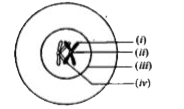Fill in the blanks with appropriate words.
The electrolytic solution is always neutral because the total charge on __(i)___ is equal to __(ii)__ on ___(iii)___ .Unlike the metallic conductor, the electrolyte conducts the electric current by virtue of movement of its ___(iv)___ . The property due to which a metal tends to go into solution in term of positive ions is known as ___(v)__.
(i),(ii),(iii),(iv) and (v ) respectively are
cations, partial charge , anions, electrons , reduction
cations , total charge , anions , ions , oxidation
cations , ionic charge , anions , atoms , dissolution
cations , partial charge , anions , molecules, electrolysis .
The correct Answer is:B
To fill in the blanks in the given statement, we can analyze each part of the statement step by step.
1. Understanding the neutrality of the electrolytic solution:
- The electrolytic solution is always neutral because the total charge on (i) cations is equal to (ii) the total charge on (iii) anions.
- This means that the positive charges from the cations balance out the negative charges from the anions, maintaining overall neutrality.
2. Current conduction in electrolytes:
- Unlike metallic conductors, the electrolyte conducts electric current by virtue of the movement of its (iv) ions.
- In electrolytes, it is the movement of charged particles (ions) that allows the conduction of electricity, as opposed to the flow of electrons in metallic conductors.
3. Understanding the property of metals in solution:
- The property due to which a metal tends to go into solution in terms of positive ions is known as (v) oxidation.
- Oxidation refers to the process where a metal loses electrons to form positive ions, which is essential in electrochemical reactions.
Now, we can summarize the filled-in blanks:
The electrolytic solution is always neutral because the total charge on (i) cations is equal to (ii) the total charge on (iii) anions. Unlike the metallic conductor, the electrolyte conducts the electric current by virtue of the movement of its (iv) ions. The property due to which a metal tends to go into solution in terms of positive ions is known as (v) oxidation.
Final Answers:
(i) cations
(ii) the total charge
(iii) anions
(iv) ions
(v) oxidation
- The electrolytic solution is always neutral because the total charge on (i) cations is equal to (ii) the total charge on (iii) anions.
- This means that the positive charges from the cations balance out the negative charges from the anions, maintaining overall neutrality.
- Unlike metallic conductors, the electrolyte conducts electric current by virtue of the movement of its (iv) ions.
- In electrolytes, it is the movement of charged particles (ions) that allows the conduction of electricity, as opposed to the flow of electrons in metallic conductors.
- The property due to which a metal tends to go into solution in terms of positive ions is known as (v) oxidation.
- Oxidation refers to the process where a metal loses electrons to form positive ions, which is essential in electrochemical reactions.
(i) cations
(ii) the total charge
(iii) anions
(iv) ions
(v) oxidation
Topper's Solved these Questions
- ELECTROCHEMISTRYBOOK - NCERT FINGERTPS ENGLISHCHAPTER - ELECTROCHEMISTRYEXERCISE - HOTS
10 Videos
- ELECTROCHEMISTRYBOOK - NCERT FINGERTPS ENGLISHCHAPTER - ELECTROCHEMISTRYEXERCISE - EXEMPLAR PROBLEMS
17 Videos
- COORDINATION COMPOUNDS BOOK - NCERT FINGERTPS ENGLISHCHAPTER - COORDINATION COMPOUNDS EXERCISE - Assertion And Reason
15 Videos
- GENERAL PRINCIPLES AND PROCESSES OF ISOLATION OF ELEMENTSBOOK - NCERT FINGERTPS ENGLISHCHAPTER - GENERAL PRINCIPLES AND PROCESSES OF ISOLATION OF ELEMENTSEXERCISE - Assertion And Reason
15 Videos
Similar Questions
Knowledge Check
Fill in the blanks by choosing the appropriate option. The noble gases can form compounds with (i) and (ii) . The mixture of (iii) and (iv) is used for respiration by divers.
A(i)(ii)(iii)(iv)iodineoxygenoxygenargonB(i)(ii)(iii)(iv)fluorineoxygenheliumoxygenC(i)(ii)(iii)(iv)xenonplatinumargonkryptonD(i)(ii)(iii)(iv)heliumoxygenxenonargon
Electrolytic conduction is due to the movement of :
View SolutionThe conduction of electricity through the electrolyte solution is due to
View SolutionWhy solution of an electrolyte is electrically neutral ?
View SolutionFor electrolytic solution, the Van't Hoff factor (i) is always equals to unity.
View SolutionLabel the structure indicated by (i), (ii), (iii) and (iv)-

View SolutionWhat is responsible for the flow of current through (i) a metallic conductor, (ii) an electrolyte?
View SolutionCan conductivity alone be used to compare the conductance of (i) metllic conductor (ii) Electrolytic conductors?
View Solution

